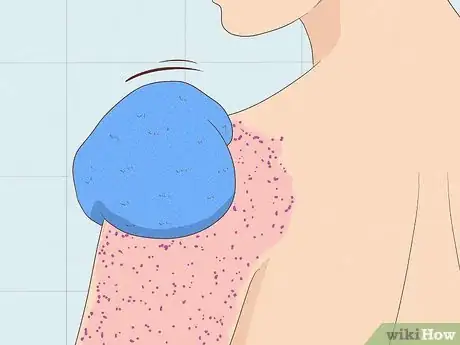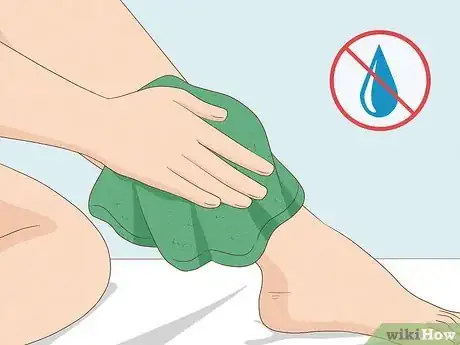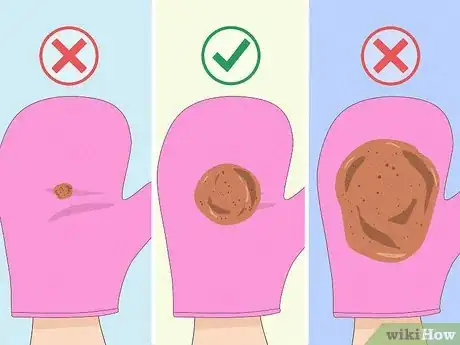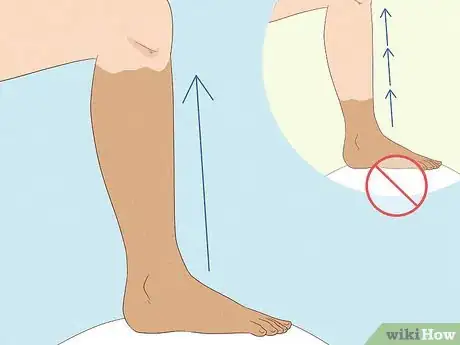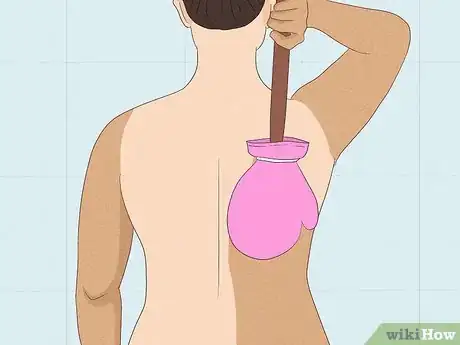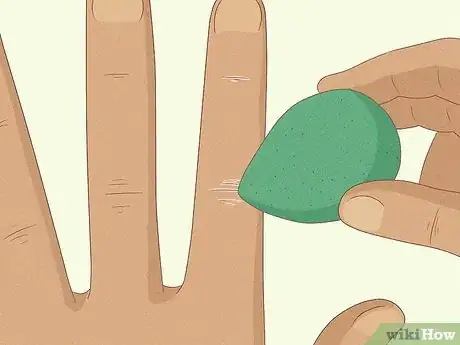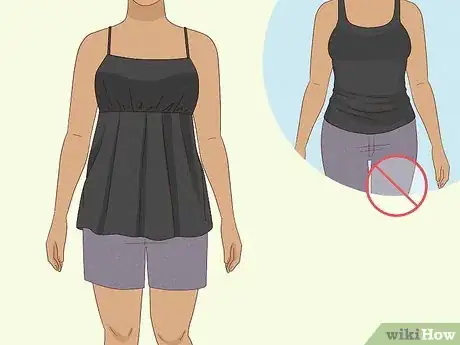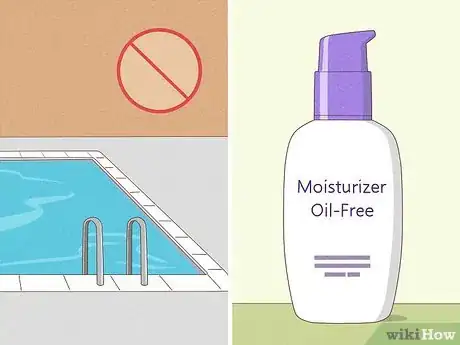This article was co-authored by Barbie Ritzman. Barbie Ritzman is a Beauty Specialist, Influencer, and the Owner of Barbie’s Beauty Bits. With over 10 years of experience in the beauty industry, she specializes in skincare and aesthetics. Barbie studied marketing at Tidewater Community College and holds a Certificate from the Media Buying Academy. For her work, she’s won Beauty Influencer of the Year - The USA and was featured in “The Allure 50,” which includes the year’s 50 most influential people in the beauty industry.
This article has been viewed 12,480 times.
Self-tanning creams are praised as a safe and easy way to achieve a sunbathed look—but anyone familiar with streaky suntans might have doubts about the “easy” part. It’s definitely possible to get a natural-looking self-tan, though. Whether you’re new to self-tanning or are trying to improve your technique, here are some strategies you can use to get a streak-free self-tan!
Steps
Cleanse and exfoliate your skin.
-
Smooth and clear skin means a less streaky tan. Sweat, oil, and products like deodorant or lotion act as a barrier against self-tanner, so you’ll want to make sure they’re completely gone. Take a shower or bath at least 8 hours before you start the tanning process, and use an oil-free body wash or exfoliating scrub to cleanse your skin. Scrub your full body with a tool—like a washcloth, loofah, or body brush—to remove any particularly stubborn oils or gunk.[1] X Trustworthy Source American Academy of Dermatology Professional organization made of over 20,000 certified dermatologists Go to source
- It's best to remove body hair the day before you tan. If you shave or wax the same day you apply the tanner, your tan can end up pretty patchy.[2] X Research source
- Don’t apply anything to your skin afterward—not even deodorant. It’ll interfere with your tan and could leave you splotchy.[3] X Research source
Make sure your skin is totally dry.
-
Damp or dripping skin will mess up your tan. When you’re putting on a self-tanner, moisture is likely to make your tan “run” and leave lines and streaks everywhere. Use a towel to fully dry your skin and hair before you begin applying your tanner. Stay out of warm or humid rooms, too, so that you don’t sweat.[4] X Trustworthy Source American Academy of Dermatology Professional organization made of over 20,000 certified dermatologists Go to source
Use lotion on too-dry spots.
-
Lotion can keep “trouble spots” from absorbing tanner too quickly. Usually, you want to skip lotion when self-tanning, but dry skin is an exception to that: it tends to soak up tanner way too fast, making it look streaky or discolored. Use an oil-free lotion to moisturize your elbows, knees, wrists, hands, ankles, and feet; these are the areas with the driest skin.[5] X Trustworthy Source American Academy of Dermatology Professional organization made of over 20,000 certified dermatologists Go to source
- If the skin on your face is dry, you might also want to apply lotion to your face.
- If you don’t have any lotion on hand, you can also blot your skin with a wet (but not dripping!) towel. It's not ideal, but as long as you don't use too much water, your tan shouldn't streak.[6] X Trustworthy Source American Academy of Dermatology Professional organization made of over 20,000 certified dermatologists Go to source
Try using a fabric applicator, like a tanning mitt.
-
A flat, even surface gives you a smoother tan. Putting on tanner with bare hands won’t necessarily get you the most even application, and you can end up with really stained hands. Spreading your tanner across a cloth or fabric surface first will give you an even layer. Many people recommend putting your self-tanner on a tanning mitt, but any fabric that wraps around your hand will work: for instance, old socks.[7] X Research source
- If you don’t have anything available, you can use your bare hands. Just remember to wash them thoroughly after each section.[8] X Trustworthy Source American Academy of Dermatology Professional organization made of over 20,000 certified dermatologists Go to source
- Rubber gloves can work for self-tanner, but if they’re loose or wrinkly, they might not apply the tanner evenly.
Use a moderate amount of tanner.
-
It’s vital to find the sweet spot between “too much” and “too little”. Slapping on a thick coat of self-tanner means you’re less likely to get an even tan—and you could wind up with a more intense tan than you wanted. A really thin layer can give you streaks too, though: if you don’t have enough, your hand or mitt can “catch.” If you have enough tanner, your hand or mitt will glide smoothly over your skin as you apply it.[9] X Research source
- There's no one "correct" amount of tanner to use. You might need to experiment a little to figure out how much you need.
- To start, make sure there’s enough product on your hand or mitt to cover the entire area you want to tan.
Put the tanner on in sections, using long strokes.
-
Long “sweeping” strokes cover your skin more evenly. You might be tempted to put on self-tanner in small patches at a time or work on your arms and chest first. But it’s actually more helpful to apply self-tanner at your ankles first, and to “sweep” it across your skin as you make your way upwards. You’ll cover a wider area and are less likely to wind up with streaks.[10] X Research source
- Try not to bend your fingers. The tanner will go on more smoothly if you keep your palm flat.[11] X Research source
- Check yourself periodically in the mirror to make sure you haven’t missed any spots.
Use tools with long handles to tackle your back.
-
Long-handled brushes or sticks make even coverage easier. It can be tricky trying to reach that "one spot" on your back, and asking someone else to help you is a pretty big exercise in trust. If you have a tool with a long handle, though—like a body brush or back-scratcher, or even a spoon or stick—you can put a tanning mitt or old sock on the end, and rubber-band it in place. Use wide, sweeping strokes to put the tanner on your back.[12] X Research source
Get the smaller spots with sponges or brushes.
-
“Painting” on your tan can hide streaks and crease marks. Evenly applying tanner into creases, folds, or small areas is impossible with tanning mitts or other large tools. But if you add some self-tanner to a foundation sponge or makeup brush, you can more easily get the tan into those tough spots. Wipe off any extra tanner, and quickly sweep the brush in a circle over the creases or small spots.[13] X Research source
- This method is great for applying tanner to your knees, underarms, fingers, and toes.
- If you don’t have a foundation sponge, a sponge paintbrush also works.
Allow your tan to “set” for a few hours.
-
You don’t want to ruin your tan right after finishing it! Most self-tanners need 6 or 8 hours to develop, and moisture or friction can mess up all your hard work. It’s usually okay to get dressed 10 minutes after applying your tanner, but put on loose clothing rather than anything form-fitting. You’ll also want to hold off on exercising, hanging out in the heat, or swimming; water or sweat can still give you a “runny” tan at this point.[14] X Trustworthy Source American Academy of Dermatology Professional organization made of over 20,000 certified dermatologists Go to source
- Try not to touch your skin too much; it can leave marks.
- Avoid showering for 10 hours after applying the tanner.
Avoid oil or chlorinated water.
-
Your tan isn’t invincible after it sets. While self-tanner won’t easily streak after it’s fully soaked in, oil-based products or water can definitely break it down, leaving it patchy or uneven. Make sure that your self-care products (like shampoo, body wash, and moisturizer) don’t contain oil, and try to limit your time in the pool—oil and chlorine, in particular, don’t play nicely with self-tanner.[15] X Research source
- Most of the time, your tan will naturally fade in about a week, so don’t worry if your tan looks like it’s fading after a few days.
Exfoliate streaks to fade them away.
-
Streaks don’t always mean you need to redo your whole tan. Don’t panic if you realize your skin looks streaky! Instead, grab a washcloth or exfoliation brush, and gently rub the streaks with a tiny bit of exfoliating scrub. Eventually, the streaks will fade and blend into the rest of your tan. You can touch it up with more self-tanner afterward, if need be.[16] X Research source
- Makeup removal wipes will also fade self-tanner, but they’re better for fixing huge discolored patches, not small streaks.
You Might Also Like














References
- ↑ https://www.aad.org/public/everyday-care/skin-care-secrets/routine/apply-self-tanner
- ↑ https://www.glamourmagazine.co.uk/article/how-to-apply-fake-tan
- ↑ https://www.independent.co.uk/life-style/fashion/fake-tan-guide-how-apply-tips-mistake-best-formula-a8957361.html
- ↑ https://www.aad.org/public/everyday-care/skin-care-secrets/routine/apply-self-tanner
- ↑ https://www.aad.org/public/everyday-care/skin-care-secrets/routine/apply-self-tanner
- ↑ https://www.aad.org/public/everyday-care/skin-care-secrets/routine/apply-self-tanner
- ↑ https://www.glamourmagazine.co.uk/article/how-to-apply-fake-tan
- ↑ https://www.aad.org/public/everyday-care/skin-care-secrets/routine/apply-self-tanner
- ↑ https://fashionmagazine.com/beauty-grooming/self-tanner-mistakes/
- ↑ https://www.independent.co.uk/life-style/fashion/fake-tan-guide-how-apply-tips-mistake-best-formula-a8957361.html
- ↑ https://fashionmagazine.com/beauty-grooming/self-tanner-mistakes/
- ↑ https://www.independent.co.uk/life-style/fashion/fake-tan-guide-how-apply-tips-mistake-best-formula-a8957361.html
- ↑ https://www.independent.co.uk/life-style/fashion/fake-tan-guide-how-apply-tips-mistake-best-formula-a8957361.html
- ↑ https://www.aad.org/public/everyday-care/skin-care-secrets/routine/apply-self-tanner
- ↑ https://www.independent.co.uk/life-style/fashion/fake-tan-guide-how-apply-tips-mistake-best-formula-a8957361.html
- ↑ https://fashionmagazine.com/beauty-grooming/self-tanner-mistakes/
About This Article

